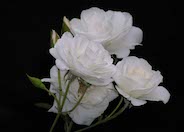
Common name: Iceberg Floribunda Rose
Botanical name: Rosa 'Iceberg'
This is a shrub rose (there are climbing varieties) with an abundance of fragrant, medium sized, white blooms. It is one of the most popular roses and very tough.
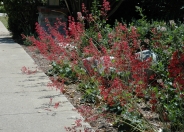
Common name: South Western Coral Bells
Botanical name: Heuchera sanguinea
Tufts of round leaves 2"-3" wide with scalloped edges accent this plant. It also produces wiry stems to 24" tall with open clusters of tiny, reddish pink, bell-shaped, fragrant flowers. Native to Desert Southwest so it tolerates desert heat, not humidity of deep South. It can also be grown in Colorado and Oregon in full sun with cool temperatures. This Heuchera typically spreads 12". Flowers can be used for vases. Prune spent flowers to encourage more blooming. This perennial has a mounding habit. In warmer and hot areas, plant in shade or part shade. This plant does best with well draining, fertile, moist soil. It does not tolerate clay soil well but will perform in rocky soil. Looks great in containers or along walkways.
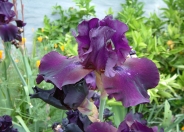
Common name: Bearded Iris
Botanical name: Iris x germanica Hybrids
This perennial will grow 1'-3' tall and has medium sized, blue green leaves with flowers of very diverse colors that bloom in spring. It needs well draining soil and full sun. Many are fragrant and rebloom several times a year. Plant rhizomes in Sept or Oct. They need water once a week during the hot spells. Top dress with compost and gypsum in January and August.
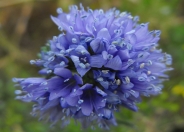
Common name: Blue Thimble Flower, Globe Gilia
Botanical name: Gilia capitata
Globe Gilia is an annual that grows 8"-30" tall and 1' wide. Pale blue to violet-blue flowers with blue pollen rise above foliage on thin stalks in spring and summer. From far, flowers look like pin cushion globes! Foliage hovers around base and is lacy looking and narrow. This wildflower tolerates heat and prefers sandy, rocky, well draining soil. It's found on hillsides in the Pacific Northwest as well as in California mountains. Bees and butterflies love the flowers.
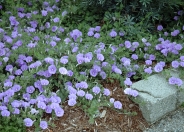
Common name: Ground Morning Glory
Botanical name: Convolvulus sabatius
A creeping perennial, typically used as a ground cover, may spread 3' wide but only reaching 1' tall. Ground Morning Glory bears small, light lavender blue, funnel-shaped flowers from spring through fall. Foliage is rounded, green and evergreen. Trim plant in late winter to prevent it from getting too woody. It can bloom through mild winters, and requires sun to part shade with little or no summer watering when established. It needs well draining soil and will tolerate clay and alkaline soil. It can grow near coastal areas. It is grown as an annual in colder (frost) winters. A great plant between other plants, in containers and in hanging baskets, in rock gardens.
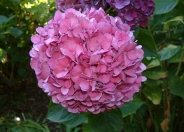
Common name: Bigleaf Hydrangea
Botanical name: Hydrangea macrophylla
This deciduous shrub has large elliptical, rich green foliage. It has large, showy flowers in lacecap form (flattened clusters of small flowers) or mophead form (spherical flower clusters). Flower color depends on soil pH: blue means soil is acidic, pink or lilac means pH is slightly acidic or alkaline. Add aluminum sulfate to turn flowers bluer. Add lime to turn flowers pinker. Add these amendments in early spring, well below flowering season of July and August. Prune after flowering period. Mulch soil well to protect plants during winter. Parts of the plant are poisonous. It grows to 3'-6' tall and wide. It prefers partial shade with fertile, moist, well draining soil. It can grow in full sun if soil is constantly moist. Deer may eat leaves.